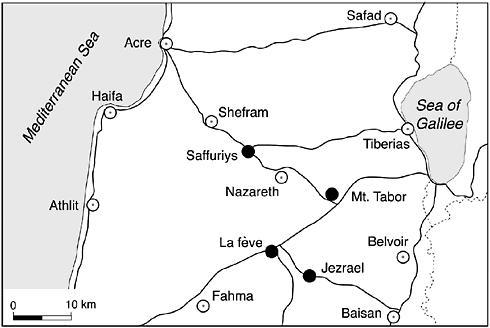Muslim Fortresses in the Levant: Between Crusaders and Mongols (16 page)
Read Muslim Fortresses in the Levant: Between Crusaders and Mongols Online
Authors: Kate Raphael
Tags: #Arts & Photography, #Architecture, #Buildings, #History, #Middle East, #Egypt, #Politics & Social Sciences, #Social Sciences, #Human Geography, #Building Types & Styles, #World, #Medieval, #Humanities


Map 1.3
Frankish fortresses in the vicinity of Mount Tabor
derived from their loyalty to and respect for his father. This was the case at where Usāma, one of the most important amirs who served under
where Usāma, one of the most important amirs who served under , continued to govern the fortress until falling into disfavor in 1212.
, continued to govern the fortress until falling into disfavor in 1212.
78
This educed ’s ability to dictate or make changes in local or regional policies.
’s ability to dictate or make changes in local or regional policies.
79 rise to power in 596/1200 changed matters throughout the region. As noted above, it was
rise to power in 596/1200 changed matters throughout the region. As noted above, it was son who got rid of Usāma, using the ultimate reason – treason against the Sultan.
son who got rid of Usāma, using the ultimate reason – treason against the Sultan.
The reasons behind the construction and the Franks’ response
It is not quite clear what precisely led to the decision to build a fortress on Mount Tabor, as it seems that raiding expeditions were being conducted by both sides. In 601/1204–5 the Franks, perhaps a group of newcomers that had just arrived from Europe, landed in Acre. Obviously lacking a strong commander, they decided almost of their own accord to raid the Muslim territories. Ibn al-Athīr claims that their raiding expeditions reached as far as Trans-Jordan, ravaging and plundering, and killing many villagers. retaliated and set out the same year to raid Frankish territory. Later in that year an agreement was signed between the two sides.
retaliated and set out the same year to raid Frankish territory. Later in that year an agreement was signed between the two sides. gave the Franks Sidon, Nazareth and a few other cities and returned to Egypt.
gave the Franks Sidon, Nazareth and a few other cities and returned to Egypt.
80
In 606/1210 a Muslim contingent left Damascus and raided the Frankish villages along the coast. Once the soldiers were satisfied they went up to Mount Tabor. No further details are given as to why they decided to stop and rest at Mount Tabor or whether they attacked the monasteries.
81
This indeed was the nature of the warfare between the Franks and the Ayyubids during the early thirteenth century: raid and counter-raid with periods of truce and no major large-scale battles.
82
Returning to the question above, the fortress may have been built in order to strengthen rule over the Galilee and to prevent the Franks from using Nazareth as a jumping point for raiding Muslim territories further north.
rule over the Galilee and to prevent the Franks from using Nazareth as a jumping point for raiding Muslim territories further north.
83
Ibn and Ibn al-Athīr both remark that
and Ibn al-Athīr both remark that decided to destroy Kawkab (Belvoir) and to build a fortress at Mount Tabor.
decided to destroy Kawkab (Belvoir) and to build a fortress at Mount Tabor.
84
The impression one is left with is that he was determined to have a stronghold of his own to supervise the region. It seems we must remain with Benvenisti’s suggestion, based on Ibn al-Athīr’s description, that it was the Franks’ repeated raids (although the sources document only the one raid during 601/1204–5 from Acre inland to the Galilee) that led the Sultan to build a new fortress.
85
The construction of a large-scale fortress in order to solve an immediate problem that troubled the region was not a revolutionary idea. Although the decision seemed a sound one at the time, taking into consideration the local state of affairs, seven years later (614/1217) it turned out to have been an expensive mistake, or, in the words of Ibn : “Its building was pointless.”
: “Its building was pointless.”
86